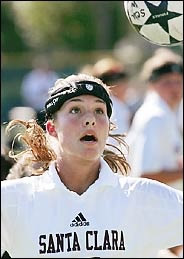By Ray Alley
 There comes a time when things need to change. Often change comes slowly, unless it is looking right into your eyes and shouting “It’s time to do it.”
There comes a time when things need to change. Often change comes slowly, unless it is looking right into your eyes and shouting “It’s time to do it.”
It’s time to stop looking the other way when the topic of concussions comes up. It’s not just an issue with collegiate football and the National Football League.
That message became obvious when Richmond forward Becca Wann and Stanford goalkeeper Emily Oliver were forced to give up the sport because they had suffered one too many concussions.
And they aren’t the first soccer players who have had their soccer careers cut short. Ross Paule, Brianna Scurry, Taylor Twellman, Alecko Escandarian, Cindy Parlow all had concussion issues that resulted in their playing careers coming to an end prematurely.
A little over a year ago Brian Namoff filed a lawsuit against D.C. United claiming negligence in dealing with his concussions.
Every year in every league boys and girls are suffering concussions. And they aren’t suffering them as a result of heading the soccer ball. They occur when the head hits a really hard object….another head, the ground, the goalpost, knee, an elbow, and sometimes, in the case of a goalkeeper, a foot.
Studies have been made regarding brain damage from heading the ball. That’s all together a different subject.
Let’s be clear, headgear has yet to be developed that will prevent a concussion, but there is equipment on the market that can lessen impact and help reduce the severity of a concussion
Soccer is the #1 sport for girls who suffer concussions while playing.
Yes, having coached soccer for over 45 years, I am aware that getting a player to wear head gear is a difficult challenge. Especially, if that player is the only one on the team wearing it.
So make it mandatory for everyone. Every Pee-Wee football player wears a helmet, every Little League baseball player wears a batting helmet. Collegiate players and the pros wear them also.
Wearing shin guards used to not be popular not so many years ago. Still isn’t, but players wear them today. It’s mandatory. It’s the rule.
Who can predict when an accident will occur, or to whom it will occur. Don’t allow it to be optional.
The Princeton, NJ, school district became the first in the state to require headgear for soccer, lacrosse and field hockey players at the sixth grade level.
It’s a rule that school officials want to push up the grade levels into high school sports.
The headgear, funded by the school board at no cost to the individual students, had a soft exterior and covered the temples, the forehead and the top of the head.
There are those who oppose headgear who say it makes players too reliant on the protection and causes them to be more reckless and actually incur more injuries
There are those who say it is unnecessary, and that injuries are part of sports
I agree with the second part of that last sentence. Injuries will occur regardless of whatever protection is available. Broken arms and legs, jammed fingers, sprains and strains. Yes to all of those.
But we have two arms and two legs, lots of fingers and toes. Those will heal, but we only have one heart and one brain. They are supposed to last us a lifetime, and we are less sure that injury to those will all-together heal.
There are several popular types of headgear on the market, including some that are simply padded head bands. Some are likely to work better than others.
More and more we are seeing college and professional players wearing one. Petr Cech, goalkeeper for EPL powerhouse Chelsea and the Czech Republic, is perhaps the most famous pro-fessional player wearing headgear.
Several years back he also wore a mask while playing. Neither were a problem for the Chelsea goalkeeper. They kept him safer than he would have been without them.
And that’s the point. Safer!
After suffering more than one concussion, both Tran and Oliver put on the headgear
Did it prevent either of them from suffering one more too many? No it did not, but we don’t know how much they may has received less of an impact and survived other bumps a knocks that might have resulted in earlier concussions.
I know articles like this will be welcome by equipment manufacturers and sports marketing specialists. So be it.
And here is the challenge to them. Make a better product.
The goal is make a headgear that will prevent a concussion from happening. That should be the goal.
It is likely that goal will never be realized, but the closer those who make the headgear come to achieving it, the more players will be safer because they are wearing it.
But as good as a piece of equipment is, it must be used to be effective. Headgear must be worn.
It should not be an option. It should not be a player decision, or even a parent decision.
Make it mandatory. Make it the rule. Wearing one will be less uncomfortable in time. Wearing one will not cause an injury or prevent one when the impact is significant, but it might lessen the severity of one.
What do you think?
